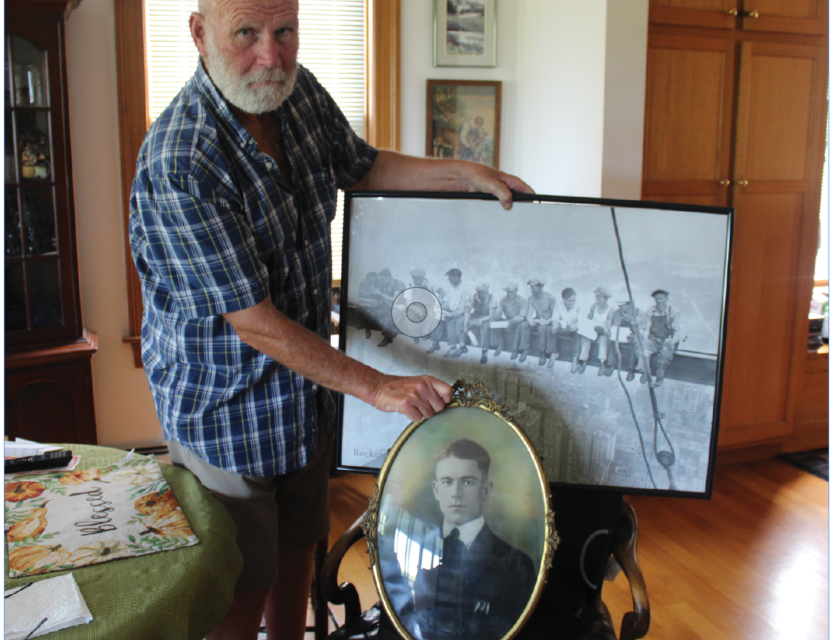ROWLEY – Michael Kovalchuk remembers that the first time he saw one of the country’s most famous photographs he was dining at the American Barbecue restaurant. In the restroom hung the photo called Lunch at Top of a Skyscraper.
Most of us have seen it. Eleven immigrant ironworkers, building Rockefeller Center in midtown New York City, posed for a publicity shot when an unknown photographer bought them lunch on Sept. 30, 1932.
They sat eating and chatting on a steel girder suspended 850 feet above the city below.
What startled Kovalchuk is he recognized two of the ironworkers, the men sitting third and fourth from the left on the girder. The third man, wearing bib overalls with boots and thick gloves, was a man he called Kumba Joe, Joseph Eckner, a Boston ironworker.
Kovalchuk was even more surprised to recognize the fourth man on the girder, who was chatting with Eckner. Previously unidentified, the man was his grandfather, Michael Gianchetta, who had largely raised him.
His grandfather never mentioned being in such a famous photo, but Kovalchuk knew it was his grandfather, not just by his facial features, but also by the clothes he wore.
He remembers his grandfather, who farmed several properties in Beverly, Ipswich and Rowley between being an ironworker, wore those same style of clothes most days of his life – high boots, khaki pants and a light-colored shirt.
Lunch atop a Skyscraper, a black-and-white photograph, was taken as a publicity stunt to promote the construction of the RCA Building at the end of the Great Depression.
The photograph’s negative, which is preserved in the Bettmann Archive, owned by the Visual China Group, has been the subject of YouTube videos, magazine covers and advertising campaigns. Each man has been sculpted, including one set of the men that sits on a mantel in Meehan’s Restaurant in Huntington, NY.
It even became a New York City tourist attraction for a few years with people paying to sit on a similar beam as it was hoisted into the air.
Kovalchuk grew up with Eckner and his grandfather. “I spent more time as a child with my grandfather than with my own parents,” he said last week. Today, he owns a home and operates a wood cutting business on Rte. 1A Main Street in Rowley.
“I have been cutting wood all my life,” he said. It was a skill he learned from his grandfather.
Gianchetta lived a colorful life. When he was a young boy, his parents, who lived in the central Italian town of Isernia, sent him to America. But when the young Gianchetta was being processed through Ellis Island in New York City, he was so distraught his face was bright red. He was thought to be ill and was returned to Italy.
When Kovalchuk, who has been on a multi-year research project to learn about his grandfather’s early life, did not find Gianchetta’s name on the list of immigrants that came through Ellis Island, he figured out that the boy’s parents booked his second passage on a trans-Atlantic ship. Paying passengers were not processed through Ellis Island, he said.
Gianchetta married a woman named Jenny and lived on several North Shore properties he bought. Called a man of foresight by his grandson, Gianchetta believed the best investment he could make was in land. He bought and worked several properties in Rowley, including land on Warehouse Lane from Rte. 1A to the Perley Marina.
One of his passions was ballroom dancing, and when he was in New York for an extended time, he met a woman while dancing. She became pregnant and gave birth to a daughter named Anne.
The woman did not want to keep the baby, so Gianchetta brought the infant home to Massachusetts. His wife Jenny, who could not have children, raised Anne. She grew up, married and gave birth to Kovalchuk.
Gianchetta died on May 24, 1975, while his grandson, an avid whitewater canoer, was on a canoe trip from Canada to Massachusetts. Gianchetta was buried in the Rowley Cemetery.
Not long after Gianchetta died, Kovalchuk’s mother, Anne, died from eating contaminated meat on a trip to Europe. Her death is one of the world’s rare cases of mad cow disease infecting humans.
After Anne died, Gianchetta married Josephine. Years later, Josephine moved to Italy and after exhuming her husband’s body and moved there together. The headstone in Rowley Cemetery remains.
Numerous claims have been made regarding the identities of the men in the image. The 2012 documentary, Men at Lunch, investigated claims that two of the men were Irish immigrants, and the director reported in 2013 that he planned to follow up on other claims from Swedish relatives that their relatives were on the beam.
The film confirmed the identities of two men: Eckner, third from the left, and Joe Curtis, third from the right, by cross-referencing with other pictures taken the same day, in which they were named. The first man from the right, holding a bottle, is also believed to be a Slovak worker Gustáv Popovič. The photograph was found in his estate, with the note “Don’t you worry, my dear Mariška, as you can see I’m still with bottle.”
Kovalchuk said he immediately recognized Eckner in the photo from a strange visit to his house. Accompanied by his younger brother, Kovalchuk recalls that Eckner’s dog bit his brother between his eyes.
Stunned, Kovalchuk stared at Eckner, his features etched in his brain, expecting him to punish the dog, But he only picked up the dog and closed the front door on the boys.




